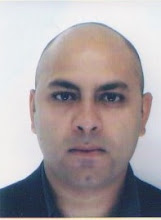
So I am now a Spanish resident and live at the very tip of North Africa. The city is called Ceuta and it is located on the African continent, about seventeen kilometers from Gibraltar, the British rock to the south of Spain. On a clear day the Spanish peninsular is immensely clear and on the other side of the city is the Mediterranean Sea and the Moroccan horizon.
I hate to channel and criticise so early on in my new home and I am a firm believer that first impressions mean very little in the grand scheme of ones definitive opinions. Nevertheless I thought it would serve as useful to at least compare how I feel about the place now and view how my sentiments will change in the months to come.
Ceuta neither really feels like Spain nor like Africa. It does not feel like limbo though either – a confused or incongruous space between two continents - but I would understand those who felt it did.
Ceuta is politically called la “Cuidad Autonoma de Ceuta”; autonomy remains an integral part of the culture and the people. And so does individuality it seems.
“Ceutis” are very proud but are distinctly split when it comes to national politics…or nationalism. There are two main political parties in Spain, the PP (Partido Popular) and the PSOE (Partido Socialista); the latter is that of the current president, Zapatero. Due to its geopolitical positioning, it is fair to say that some Ceutis feel hard done by with regards to the influx of immigrants looking to reach mainland Spain.
 Since the authorities will not accept the migrants across the 17km strip and Morocco refuses to allow them back down into the heart of Africa, they are left in migrant camps outside the city.
Since the authorities will not accept the migrants across the 17km strip and Morocco refuses to allow them back down into the heart of Africa, they are left in migrant camps outside the city.
This puts a large financial strain on the local economy. It also encapsulates how Ceuta feels sometimes.
So close and yet so far, both from Spain geographically but also what the city represents. It almost feels confused, hard done by, spending years defending its territory for its Spanish neighbours across the Gibraltar strait.
For this very reason, some locals adopt a strictly conservative look on life, almost a subconscious push to preserve the land their ancestors fought to protect. Then there are those who enjoy the eclectic feel of the city and embrace the ethnic diversity. I have not yet met someone who is centrist, with balanced opinions on both political ends of the spectrum. It is early days though.
The racial makeup of the locals is also intriguing. Are they native Spanish with some Moorish blood, or the reverse; are they Portuguese descendants with Moorish roots or the reverse; where do the Jews and Hindus fit into the city?
Well, quite simply, Ceutis like to be seen as first Spanish Caucasian, then European by political association. Ceuta is quite clearly Africa on a map but you would not dare say that to a local Ceuti. The other religions represented in Ceuta are Islam, Judaism and Hinduism – all have their own temples and all have resided in Ceuta for over a century.
However those that represent these religions – Moroccans, Indians etc. all live in their detached communities and there is little noticeable meshing of cultures. I guess this can also be said of many large cities – London, New York, Paris, Madrid. A small city like Ceuta though, one expects to be different. It has been taken over, ruled and attracted a wide mix of civilisations and remains 70,000 small. The city does not cover much land, which means that in order for cultures to be separated must take some effort to achieve.
Ceuta is quiet right now and lacks youthful spirit that will arrive in the form of students come late September. The University of Granada has a campus here, the largest of which is for those studying “enfermeria” (nursing). Young people can really lift a place and change its character and landscape, not just physically but also theoretically. Since the majority of the students will also be from the Spanish mainland, that will also bring about differences to the locals here. I had no expectations of Ceuta however I did have an image of what it may look like and feel. But I am still calculating the place and its residents.
It is a very exciting place and carries a lot of political leverage, especially towards Morocco. I look forward to settling in and enveloping myself within all that Ceuta has to offer.

















